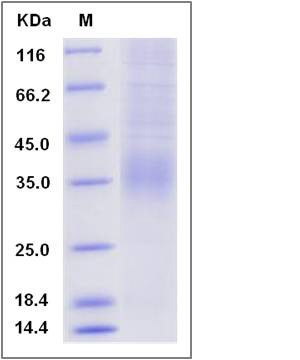Rat 4-1BBL / CD137L / TNFSF9 Protein (His Tag)
TNFSF9
- 100ug (NPP1720) Please inquiry
| Catalog Number | P80166-R07H |
|---|---|
| Organism Species | Rat |
| Host | Human Cells |
| Synonyms | TNFSF9 |
| Molecular Weight | The recombinant rat TNFSF9 comprises 223 amino acids and has a predicted molecular mass of 24.8 kDa. The apparent molecular mass of the protein is approximately 35 kDa in SDS-PAGE under reducing conditions. |
| predicted N | His |
| SDS-PAGE |  |
| Purity | > 88 % as determined by SDS-PAGE |
| Protein Construction | A DNA sequence encoding the rat TNFSF9 (Q80WE6) (Pro106-Gly308) was expressed, fused with a polyhistidine tag at the N-terminus. |
| Bio-activity | |
| Research Area | Cancer |Cancer immunology |Cytokine & Receptor |Tumor Necrosis Factor (TNF) & Receptor |TNF Receptor |
| Formulation | Lyophilized from sterile PBS, pH 7.4 1. Normally 5 % - 8 % trehalose, mannitol and 0.01% Tween80 are added as protectants before lyophilization. Specific concentrations are included in the hardcopy of COA. |
| Background | 4-1BBL is the high affinity ligand of 4-1BB, also known as CD137L or TNFSF9. It is shown to be a type II surface glycoprotein belonging to the TNF superfamily. Expression of 4-1BBL is restricted to APCs, such as dendritic cells, macrophages, and activated B cells. Members of the TNF-TNF receptor superfamily have been shown to play critical roles in regulating cellular activation, differentiation and apoptosis. Several studies have reported that 4-1BBL/4-1BB interaction provided a co-stimulatory signal to T cells, and increased T cell proliferation and cytokines production. In additon, 4-1BBL is involved in cancers, infectious diseases and autoimmune diseases. |
| Reference |
